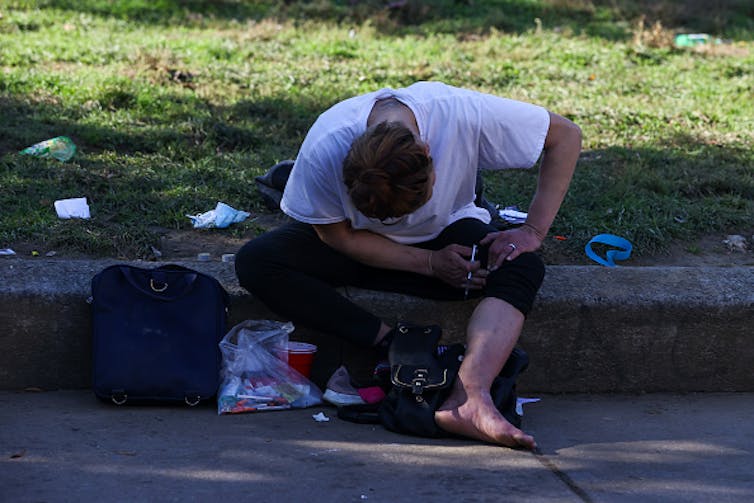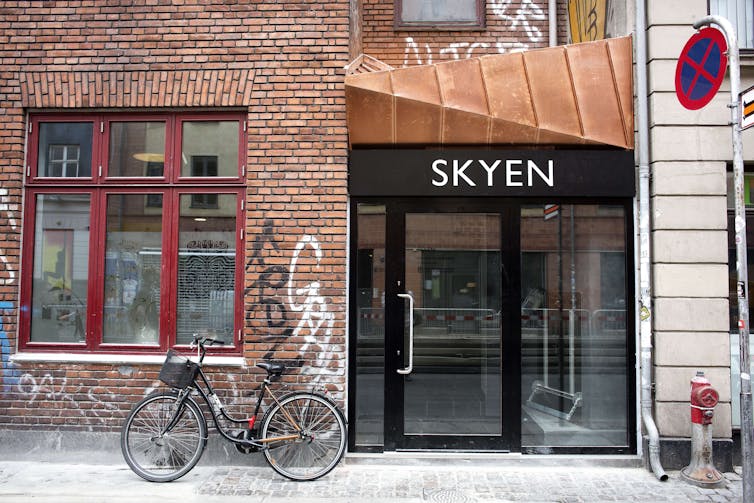The United States remains tightly in the grasp of an ongoing, and escalating, crisis of deaths caused by opioid overdoses.
With a record-high 109,000 people dying in 2022, it is clear that something new needs to be done to reverse this trend.
Philadelphia is near the epicenter of the crisis. Some of the country’s largest open-air drug markets can be found in the Kensington neighborhood. Heroin, prescription opioids and fentanyl aren’t the only drugs of concern. Xylazine, a powerful non-opioid also known as tranq, has an overwhelming presence on the streets.
We are a group of Scandinavian and American researchers who have studied drug treatment and harm reduction, and we have been watching the situation in Philadelphia from a variety of perspectives.
A mixed response
A record 1,413 people died in Philadelphia from drug overdoses in 2022. The rate of drug-related deaths for Black residents more than doubled between 2018 and 2022, mirroring a problematic national trend.
In response, Philadelphia has adopted a multifaceted plan to stem the tide of overdoses.
But Philadelphia’s City Council has overwhelmingly rejected the establishment of supervised injection sites – a potentially impactful, evidence-based tool in this fight. Overriding the mayor’s veto on Sept. 28, 2023, council members have used zoning legislation to essentially prevent the opening of sites where people can take drugs under supervision across most of the city.
In May 2023, the Pennsylvania legislature also overwhelmingly voted to ban supervised injection sites in the entire state.
While much of the political discourse surrounding this decision has focused on protecting neighborhoods where drug activity happens in parks and on the streets, ample evidence suggests that banning supervised injection sites may instead jeopardize the people and communities the policy was intended to protect.
What is harm reduction?
Supervised injection sites are an example of harm reduction, a general approach to addressing addiction and other public health crises. Ranging from efforts aimed at reducing incidences of HIV to encouraging the safer consumption of alcohol, the concept has become integral to many global public health initiatives.
The goal of harm reduction is to minimize the negative effects associated with drug use and other risky behaviors rather than solely focusing on eliminating the activity. This approach acknowledges the difficulty in breaking addictive behaviors and the fact that some individuals won’t – or can’t – stop regardless of policy and social efforts.
For drug use, harm reduction takes many forms. These include encouraging nonjudgmental approaches toward people who use drugs among social service workers and health care personnel, needle exchange programs, distribution of drugs that reverse overdoses, testing drugs for safety – and, in many parts of the world, supervised injection sites.
Limitations in the United States
Supervised injection sites have been a particularly controversial approach to harm reduction not just in Philadelphia but across most of the U.S.
Only a few officially sanctioned supervised injection sites have emerged. Two opened in Manhattan in 2021 with support from the government of New York City, where research suggests they could save both lives and health care dollars. Rhode Island plans to open a third in Providence in spring 2024, permitted by state legislation. The legality of even these rare sites in the U.S. remains unclear under federal law, according to a 2011 study.

Tayfun Coskun/Anadolu Agency via Getty Images
In the face of this uncertain legality, scant evidence from the U.S. is available. One unsanctioned site operating in secrecy was studied by academics. They found that 90% of users reported they would otherwise have been injecting in parks, streets or public restrooms, meaning the site averted over 2,300 public injections and safely disposed of at least 1,700 needles over two years.
Beyond this, policymakers have limited research in the U.S. to draw upon – and so it is informative to look abroad.
Globally, over 100 supervised injection sites are currently operating in 10 countries, including Canada and across Europe. Researchers have looked to experiences in Denmark and Norway, in particular, to study drug consumption rooms. Despite clear differences between Scandinavia and Philadelphia, the research and evidence highlight the potential impact of this form of harm reduction.
The evidence from Norway
In Norway, as in the U.S., harm-reduction efforts first began with opioid substitution therapy, meaning the provision of less dangerous drugs like methadone for opioid users.
When overdose rates kept rising, supervised injection sites where people who use drugs could get clean needles and be observed while using drugs were piloted in 2005 and made permanent by 2009.
The Norwegian Institute of Public Health collected data on the impact of the supervised injection site in Oslo. Just over 150 people used the site in 2005, the first year it opened. Two years later, demand had almost quadrupled. After just six months of operation, staff were recording over 900 injections per month, each diverted from the street. People using the facility told researchers their sense of human dignity improved.
Staff reported that the site allowed them to directly connect more people to social and health services. Other data shows that the presence of the site has reduced the use of ambulances and related public services, preserving those resources for the community.
Striking results in Denmark
The first official Danish supervised injection site opened its doors in Copenhagen in 2012, though underground versions had been operating for a few years.
Since then, several studies have shown the Copenhagen sites not only prevented many drug-related deaths, but improved overall health by successfully connecting people to substance abuse treatment and other health care services.
Staff were also successful at educating people about more hygienic injection techniques, thereby reducing infections and other drug-related complications that often lead to hospitalization. After the sites were opened, fewer people openly used drugs in Copenhagen’s parks and streets. Property values near the injection sites were unaffected.
An evaluation by the Danish Ministry of Health found that the number of needles and syringes discarded in the city’s public spaces was reduced by 70% to 80%, and residents in surrounding neighborhoods said their quality of life improved.

Niels Ahlmann Olesen/AFP via Getty Images
Copenhagen’s experience also highlights the essential fact that supervised injection sites alone aren’t a solution; they are only a part of an effective harm-reduction strategy and must be accompanied by social support and other programming.
For example, the Users’ Academy – or Brugernes Akademi in Danish – is a national nonprofit led by people who use drugs that offers a wide range of harm-reduction services directly to their peers. They run a needle exchange program through the mail and raise awareness regarding the legal rights of people who use drugs. They also operate a mobile health clinic that seeks to prevent diseases like hepatitis C and reduce barriers to health and social services.
An opportunity to investigate
Even in the face of the ongoing controversy in Philadelphia, new ideas are emerging.
Using the infusion of funding from national opioid settlements, Philadelphia could explore more politically acceptable approaches to harm reduction while collecting evidence and building support for a permanent supervised injection site.
In some European cities, mobile supervised injection sites have been adopted first. In Copenhagen, Fixelancen, an old ambulance, has been refurnished as a low-cost supervised injection site. It can service different areas of the city as the drug scene rapidly evolves, avoiding the focus and burden on a particular neighborhood. Such an approach could easily complement other mobile harm-reduction efforts already operating in Philadelphia.
Stay connected with us on social media platform for instant update click here to join our Twitter, & Facebook
We are now on Telegram. Click here to join our channel (@TechiUpdate) and stay updated with the latest Technology headlines.
For all the latest Health News Click Here
For the latest news and updates, follow us on Google News.
